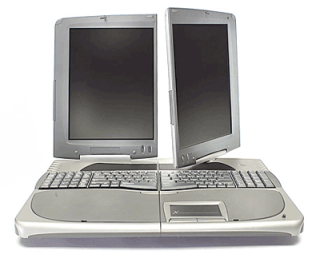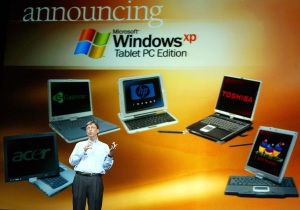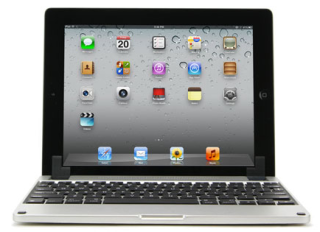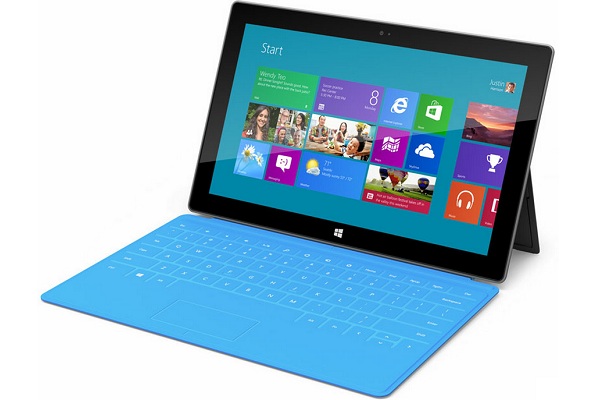The Grid Compass, the first clamshell-case laptop computer
In the early 1990s, for instance, Zeos’s Freestyle let you swivel its screen, a design which looked appealing to me at the time but didn’t go anywhere.

Google Patents
I’m also fond of a perversely brilliant 1996 patent on a laptop design that was part clamshell, part giraffe: Telescoping extensions and rear support stalks let you raise the screen to eye level. Like nearly every modified clamshell, it complicated what had been elegantly simple without enough new benefits. In patent-drawing form, the whole setup looks rather precarious; as far as I know it never hit the market.
Others have tried to cram two screens into one laptop, such as Xentex’s Flip-Pad Voyager, which had the standard clamshell hinge plus another in the middle of the keyboard, and twin 13.3″ screens which could be spun about separately. (It made a bit of a splash in 2003, but either never shipped or came and went so quickly that it might as well not have.)

PCMag.com
The most concerted, high-profile effort of all to transform the clamshell into something new was the Tablet PC, which Microsoft began promoting in 2000 as the future of mobile computing. Bill Gates famously predicted that it would dominate the market within five years, a prognostication which I’m sure was sincere but turned out to be spectacularly off-base.
Some Tablet PCs were proto-iPads: slabs without a hinge or a keyboard. Most, however, were convertibles, with newfangled hinges which let you open the case like a conventional laptop or flip the screen around into tablet orientation. (The convertibles were reminiscent of a design which ever-inventive Grid itself tried late in its life.)

Getty Images
A few convertibles remain on the market, and more will presumably arrive when Windows 8, with its touch-friendly interface, ships. But within a couple of years of the Tablet PC’s debut, it was obvious that the vast majority of PC users didn’t want to convert their laptops into tablets. They just wanted to use them in pretty much the way that Grid had envisioned back in 1982.
The clamshell didn’t get a truly formidable competitor until Apple announced and shipped the first iPad in 2010. Instead of building on Grid’s 1982 innovation, as Microsoft’s Tablet PC had done, Apple’s tablet simply abandoned it. There’s no hinge and no physical keyboard: Unlike nearly every other would-be laptop replacement of the past three decades, the iPad is simpler than a conventional PC rather than more complex.

Brydge
That hasn’t stopped plenty of folks– including me–from using the iPad with external keyboards, such as Logitech’s Ultrathin Keyboard Case, in an attempt to mimic the virtues of a clamshell. The high-profile Kickstarter project Brydge goes further, turning the iPad into a genuine clamshell device which looks suspiciously like a MacBook Pro.
Then there’s Microsoft’s Surface, the first PC which the company that’s synonymous with PCs has ever designed on its own, and probably the iPad’s most ambitious rival to date. Clad in a magnesium case–like the Grid Compass–it’s a tablet, not a clamshell.

Microsoft
But the most innovative thing about Surface is its super-thin optional keyboard, which snaps onto the case magnetically. Pop it on and pull out the case’s built-in kickstand, and the Surface becomes a tablet that’s trying its darndest to duplicate the functionality of a clamshell laptop.
You’d have to be wearing technological blinders to deny that clamshell devices have finally lost their monopoly on portable computing. And you don’t have to be a brilliant futurist to see the day coming when the average mobile computing device is an iPad-style tablet, not a direct descendant of Grid’s 1982 machine.
Still, it’s hard to imagine any design rendering the the clamshell utterly obsolete. No matter how astonishing computers are in 2082 and beyond, I’ll bet that some of them will have a screen, a keyboard and a hinge in the middle. Why would the world want to give up something so fundamentally useful?
MORE: Six Tablets to Consider for Windows 8’s October Launch


